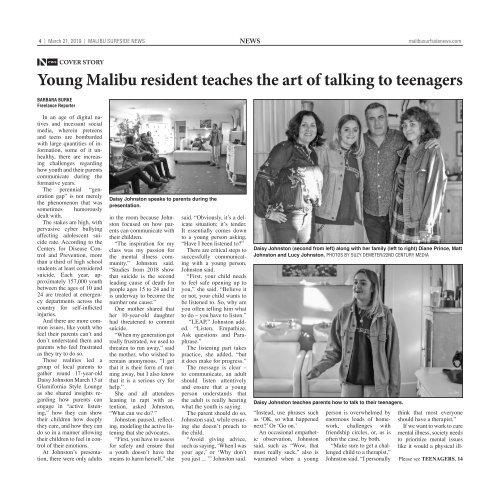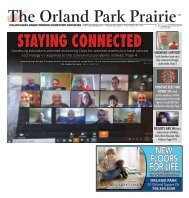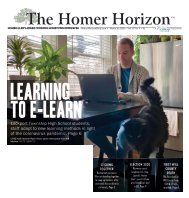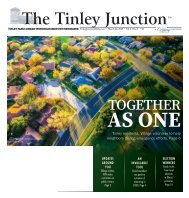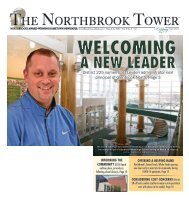MSN_032119
You also want an ePaper? Increase the reach of your titles
YUMPU automatically turns print PDFs into web optimized ePapers that Google loves.
think that most everyone<br />
should have a therapist.”<br />
If we want to work to cure<br />
mental illness, society needs<br />
to prioritize mental issues<br />
like it would a physical ill-<br />
4 | March 21, 2019 | Malibu surfside news news<br />
malibusurfsidenews.com<br />
Young Malibu resident teaches the art of talking to teenagers<br />
Barbara Burke<br />
Freelance Reporter<br />
In an age of digital natives<br />
and incessant social<br />
media, wherein preteens<br />
and teens are bombarded<br />
with large quantities of information,<br />
some of it unhealthy,<br />
there are increasing<br />
challenges regarding<br />
how youth and their parents<br />
communicate during the<br />
formative years.<br />
The perennial “generation<br />
gap” is not merely<br />
the phenomenon that was<br />
sometimes humorously<br />
dealt with.<br />
The stakes are high, with<br />
pervasive cyber bullying<br />
affecting adolescent suicide<br />
rate. According to the<br />
Centers for Disease Control<br />
and Prevention, more<br />
than a third of high school<br />
students at least considered<br />
suicide. Each year, approximately<br />
157,000 youth<br />
between the ages of 10 and<br />
24 are treated at emergency<br />
departments across the<br />
country for self-inflicted<br />
injuries.<br />
And there are more common<br />
issues, like youth who<br />
feel their parents can’t and<br />
don’t understand them and<br />
parents who feel frustrated<br />
as they try to do so.<br />
Those realities led a<br />
group of local parents to<br />
gather round 17-year-old<br />
Daisy Johnston March 13 at<br />
Glamifornia Style Lounge<br />
as she shared insights regarding<br />
how parents can<br />
engage in “active listening,”<br />
how they can show<br />
their children how deeply<br />
they care, and how they can<br />
do so in a manner allowing<br />
their children to feel in control<br />
of their emotions.<br />
At Johnston’s presentation,<br />
there were only adults<br />
Daisy Johnston speaks to parents during the<br />
presentation.<br />
in the room because Johnston<br />
focused on how parents<br />
can communicate with<br />
their children.<br />
“The inspiration for my<br />
class was my passion for<br />
the mental illness community,”<br />
Johnston said.<br />
“Studies from 2018 show<br />
that suicide is the second<br />
leading cause of death for<br />
people ages 15 to 24 and it<br />
is underway to become the<br />
number one cause.”<br />
One mother shared that<br />
her 10-year-old daughter<br />
had threatened to commit<br />
suicide.<br />
“When my generation got<br />
really frustrated, we used to<br />
threaten to run away,” said<br />
the mother, who wished to<br />
remain anonymous. “I get<br />
that it is their form of running<br />
away, but I also know<br />
that it is a serious cry for<br />
help.”<br />
She and all attendees<br />
leaning in rapt with attention,<br />
asked Johnston,<br />
“What can we do? ”<br />
Johnston paused, reflecting,<br />
modeling the active listening<br />
that she advocates.<br />
“First, you have to assess<br />
for safety and ensure that<br />
a youth doesn’t have the<br />
means to harm herself,” she<br />
said. “Obviously, it’s a delicate<br />
situation; it’s tender.<br />
It essentially comes down<br />
to a young person asking,<br />
“Have I been listened to?”<br />
There are critical steps to<br />
successfully communicating<br />
with a young person,<br />
Johnston said.<br />
“First, your child needs<br />
to feel safe opening up to<br />
you,” she said. “Believe it<br />
or not, your child wants to<br />
be listened to. So, why are<br />
you often telling him what<br />
to do – you have to listen.”<br />
“LEAP,” Johnston added.<br />
“Listen, Empathize,<br />
Ask questions and Paraphrase.”<br />
The listening part takes<br />
practice, she added, “but<br />
it does make for progress.”<br />
The message is clear –<br />
to communicate, an adult<br />
should listen attentively<br />
and ensure that a young<br />
person understands that<br />
the adult is really hearing<br />
what the youth is saying.<br />
The parent should do so,<br />
Johnston said, while ensuring<br />
she doesn’t preach to<br />
the child.<br />
“Avoid giving advice,<br />
such as saying, ‘When I was<br />
your age,’ or ‘Why don’t<br />
you just ... ’” Johnston said.<br />
Daisy Johnston (second from left) along with her family (left to right) Diane Prince, Matt<br />
Johnston and Lucy Johnston. photos by Suzy Demeter/22nd Century Media<br />
Daisy Johnston teaches parents how to talk to their teenagers.<br />
“Instead, use phrases such<br />
as ‘OK, so what happened<br />
next?’ Or ‘Go on.’<br />
An occasional empathetic<br />
observation, Johnston<br />
said, such as “Wow, that<br />
must really suck,” also is<br />
warranted when a young<br />
person is overwhelmed by<br />
enormous loads of homework,<br />
challenges with<br />
friendship circles, or, as is<br />
often the case, by both.<br />
“Make sure to get a challenged<br />
child to a therapist,”<br />
Johnston said. “I personally<br />
Please see teenagers, 14


